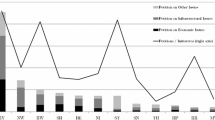Conclusion
This study has used a Tiebout-type empirical model to analyze the overall differences in performance between representative and direct democratic forms of local government. In agreement with the underlying theory of representative democracy, representative forms of local government are found to be significantly inefficient relative to the direct democratic form of local government. The findings also indicate that a great similarity in efficiency exists between council-manager and mayor-council forms of local government. Both forms of local government appear to be equally inefficient compared to the open-town meeting. Further empirical analysis demonstrates that the cost of local representative government failure may be as high as 13 percent of the typical community's property tax base, which may be cause for some alarm. It should be mentioned that the results do not suggest that open-town meeting forms of government are necessarily efficient. (The median-voter model argues otherwise.) The results only indicate that the open-town meeting can be considered more efficient relative to the other forms of local government.
Similar content being viewed by others
References
Dye, T.R. (1981). Politics in states and communities, 4th ed. Prentice-Hall.
Ehrenberg, R., and Goldstein, G. (1975). A model of public sector wage determination. Journal of Urban Economics 2: 223–245.
Johnston, J. (1972). Econometric methods, 2nd. ed. McGraw-Hill.
Mackay, R.J., and Weaver, C.L. (1978). Monopoly bureaus and fiscal outcomes: Deductive models and implications for reform. In G. Tullock and R.E. Wagner (Eds.), Policy analysis and deductive reasoning. Lexington Books.
Megdal, S.B. (1983). The determination of local public expenditures and the principal and agent relation: A case study. Public Choice 40(1): 71–86.
Niskanen, W.A. (1971). Bureaucracy and representative government. Aldine-Atherton.
Oates, W.E. (1969). The effects of property taxes and local spending on property values: An empirical study of tax capitalization and the Tiebout hypothesis. Journal of Political Economy 77: 957–971.
Pindyck, R.S., and Rubinfeld, D.L. (1976) Econometric models and economic forecasts. McGraw-Hill.
Pommerehne, W.W., and Schneider, F. (1978). Fiscal illusion, political institutions and local public spending. Kyklos 31(1): 27–43.
Richardson, H.W. (1977). On the possibility of positive rent gradients. Journal of Urban Economics 4: 60–68.
Santerre, R.E. (1985). Spatial differences in the demands for local public goods. Land Economics 61: 119–128.
Tiebout, C. (1956). A pure theory of local expenditures. Journal of Political Economy 64: 416–424.
Author information
Authors and Affiliations
Additional information
The author thanks participants of the Economics Workshop Series at Bentley College, Dennis Heffley and Laurie Bates for providing many helpful comments on an earlier version of this paper.
Rights and permissions
About this article
Cite this article
Santerre, R.E. Representative versus direct democracy: A Tiebout test of relative performance. Public Choice 48, 55–63 (1986). https://doi.org/10.1007/BF00239560
Issue Date:
DOI: https://doi.org/10.1007/BF00239560




